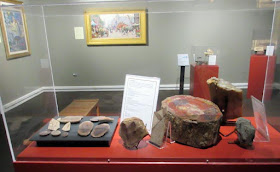Students in the École who had graduated from cast drawing and drawing from the nude model were finally allowed to paint in oil from life. The resulting study was called an "academy." The model would typically be standing in a classical pose, lit from high north windows. Students would spend a full week on each study. Here, Shinn outlines how that week was spent.
"What is really the week’s affair to the Beaux-Arts man is his 'academy.'
"On Monday he hits the pose, which is always vigorously pronounced and spirited, on the model's part, when first assumed; the dash that may be thrown into the attitude while the figure is perfectly fresh can never be caught up again if missed at the beginning.
"By Tuesday the artist has become absorbed in the complications of light and shade.
"On Wednesday the master comes, and perhaps rejects nearly everything that has been done, disfiguring and blotting the sketch from one margin to the other. The model, drooping upon his dais may bear little resemblance to the elastic attitude of the drawing, and the student is accused of attempting to idealize. 'You have been trying to modify nature from your reminiscences of the antique; you have ennobled the head, braced the shoulders,' etc. The study is altered, in the spirit of realism, until all the stark and pitiful ugliness of the model's lassitude is expressed.
"One of the difficulties of a life 'academy' is that, although the example before you is a moving, changing object, now braced, now drooping, now turned a little to the right and now a little to the left, your copy of it is expected to show all the purism of the photograph.
"If you were putting the same model into a historical picture, you would be expected to elevate the attitude and expression; and you would then begin to hear from your critics a great deal about the difficulty and responsibility of borrowing from nature, what to take and what to leave.
"'Only Phidias and Da Vinci,' I have heard declared, 'and perhaps Michelangelo, deserved to have received the revelations of anatomy.' If, on the other hand, you were copying the antique, you would have the full luxury of refining your line and your form, with no limitation of time and with
a rigid model. The life 'academy,' then, is expected to avoid the imaginative qualities of [a] picture, and to win, from a constantly deteriorating example, the accuracy which is so fascinating a quest in copying from statuary. A felicitous study is therefore a very desirable treasure, and old forgotten ones by [Thomas] Couture or [Hippolyte] Flandrin are preserved in the ateliers where those painters have studied, used as paradigms by teachers, or sold as something of unique value in the color-stores.
Albert Edelfelt (1854-1905)
"Another trouble is the variation in the color of the air on different days. 'The patron has accused me,' an energetically protesting youth will cry, 'of seeking the silver tint of Terborg; it was as far from my thoughts as silver from my pocket. But I established my key of color on Thursday, when there was a solid gray rain like slate-pencils; and the Italian turned blue and chattered; and how will you expect the tones of Titian in such a climate, my brothers?'
"On the closing day of the week I have known an incorrigibly gay lad to exhibit a canvas almost completely expunged by the blottings of the professor. 'This was to have been my masterpiece. I meant it for the altar of the church where I was baptized, whether as a St. Michael or a John in the Wilderness. The outline was good until Auguste changed it into a caricature of the Prince Imperial.'"
According to Albert Boime, "An experienced pupil could capture a head in a single session, but the others would often require several days. During the first session, the beginner sketched the head or figure, and then traced the drawing to canvas. When confronted with the live model, the pupil proceeded in much the same way as in rendering the head, only now he drew his pencil or charcoal sketch directly on the canvas. In the second session he traced the painted outline and established the principle masses of shadows in a diluted mixture of turpentine and red ochre. On the third day he prepared his palette carefully and rendered the flesh tones, as well as the hair and accessories. Finally the last session was devoted to completing the
ébauche with respect to the
tout ensemble."
-----
Excerpts from
The Nation, July 22, 1869,
Page 68. "ART-STUDY IN THE IMPERIAL SCHOOL AT PARIS" by Earl Shinn
Final quote from
The Academy and French Painting in the 19th Century
by Albert Boime
More examples of academies at
LARA (London Atelier of Representational Art)
Three excellent book sources:
The Lure of Paris: Nineteenth-Century American Painters and Their French Teachers The Studios of Paris: The Capital of Art in the Late Nineteenth Century
The Studios of Paris: The Capital of Art in the Late Nineteenth Century
Previously on GurneyJourney:
Beaux-Arts Instruction (Part 1)


.jpg)






































